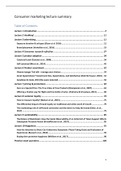Consumer marketing lecture summary
Table of Contents
Lecture 1 introduction ....................................................................................................... 2
Lecture 2 VanMoof ......................................................................................................... 11
Lecture 3 advertising....................................................................................................... 11
Exposure duration & ad types (Elsen et al. 2016) ..................................................................... 12
Brand placement (Verhellen et al., 2016) ................................................................................ 19
Lecture 4 Consumer research refresher ............................................................................ 27
Lecture 5 product adoption ............................................................................................. 34
Construal Level (Castano et al., 2008)...................................................................................... 34
Self-construal (Ma et al., 2014) ............................................................................................... 45
Lecture 6 Product assortment .......................................................................................... 52
Sheena Iyengar Ted talk – manage your choices ...................................................................... 54
Great Expectations?! Assortment Size, Expectations, and Satisfaction (Diehl & Poynor, 2010). . 54
Goodman & Irmak, 2013 (No exam material) .......................................................................... 59
Lecture 7 pricing & promotions ....................................................................................... 63
Zero as a Special Price: The True Value of Free Products (Shampanier et al., 2007) ................... 63
Offering a freebie: pay for flight and free bottle of wine. (Palmeira & Srivastava, 2013) ........... 68
Lecture 8 customer loyalty .............................................................................................. 74
How to measure loyalty? (Watson et al., 2015) ....................................................................... 75
The differential impact of brand loyalty on traditional and online word of mouth: ................... 79
The moderating role of self-brand connection and the desire to help the brand (Eelen, et al.,
2017) ..................................................................................................................................... 79
Lecture 9 sustainability ................................................................................................... 85
The Nature of Slacktivism: How the Social Observability of an Initial Act of Token Support Affects
Subsequent Prosocial Action (Kristoffersson et al., 2014). ........................................................ 85
Lecture 10 Happiness ...................................................................................................... 91
How the Intention to Share Can Undermine Enjoyment: Photo-Taking Goals and Evaluation of
Experiences (Barasch et al., 2018). .......................................................................................... 94
Buying time promotes happiness (Whillans et al., 2017) .......................................................... 98
Practice exam questions ............................................................................................... 104
1
,Lecture 1 introduction
Goals of this course: be a wise marketeer
Watch consumers in their different stages of decision making
And be aware of the
Internal, social, external forces that shape behavior.
Integrate these insights into your marketing practice.
Wise framework
Developed by professor Eesha Sharma
Goals of this course: be academic
• Analytical, logical, consistent, critical, nuanced thinking.
• Read and understand consumer research
• Experimental research method
Lectures/ knowledge clips
2
,Overview of consumer behavior
Get WISE
Wise: watch each decision-making stages
Watch each decision-making stage
Use the 5 Ws as Prompts:
• Who is the consumer?
• What internal, social, external factors influence the consumer? What interactions
does that consumer have?
• When does the consumer make the purchasing decision, and what’s going on before
purchasing, during, and after that decision?
• Where are consumers making decisions? (e.g., home, store, online; may depend on
the decision-making stage)
• Why? Aimless examination of consumer behavior can be dangerous
o Clearly define the objectives
o Define measures of success
3
,Internal influences (psychological)
Human psychology, underpinnings of choice
• Beliefs, attitudes, values
• Motives (drivers of behavior)
• Needs, wants
• Emotions
• Judgment and decision making
• Subconscious and non-conscious influences
• Information processing (we are not homo-economicus. Our decisions are susceptible
to context)
Motivation
Model of consumer motivation
Needs: desires that arise when a consumer’s actual state does not meet his or her desired
state:
• Physiological Needs—innate or primary
• Psychological Needs—secondary
Wants: learned manifestation of needs:
• Product-specific needs
Motivation:
A driving force that moves or incites consumers to act
• Motivation focuses attention on goal-relevant objects.
• Need: negatively originated motivation
• Want: positively originated motivation
4
,Social motives, Fiske (2004): BUC(K)ET
Belonging, understanding, control, self-enhancement, trust
Perception
Emotions
Basic emotions: happiness, sadness, fear, anger, disgust, surprise.
Self-conscious emotions: pride, regret, shame, guilt.
Learning and memory
Learning
The process of acquiring new information and knowledge about products and services for
application to future behavior.
Knowledge
Is created when a person makes associations between concepts.
Memory
Enables past experiences and learning to influence current behavior.
Short term memory
• Limited duration (current)
• Limited capacity
o 7 +/- bits or chunks
o Chunking
Long term memory
• Unlimited duration
• Unlimited capacity
• Efficient organization
5
, Learning and memory
Associative principle long term memory
Knowledge accessibility depends on:
a) Strength of associations
b) Number of associations
c) Frequency of concept activation
d) Recency of concept activation
Attitude
Attitude = evaluative judgment based on cognitions, affect, and behavior
Cognition influences attitude:
• Multi-Attribute model and
• Theory of Reasoned Action
• Theory of Planned Behavior
Affect influences attitude:
• Integral versus incidental affect
Dual Process Models:
• Elaboration Likelihood Model, Petty & Cacioppo
• System 1 & 2, Kahneman
Attitude
Theory of planned behavior
6






